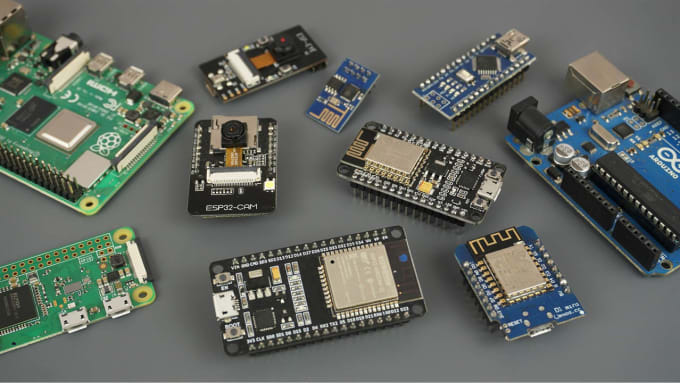
Featuring Raspberry Pi, ESP32, STM32, Arduino & Emerging Alternatives
As we step into 2025, the Internet of Things (IoT) continues to reshape industries—from smart homes and wearables to industrial automation and agriculture. At the heart of every IoT project lies a powerful embedded board—the brain that senses, processes, and communicates.
In this post, we’ll compare the best embedded boards for IoT in 2025, including trusted names like Raspberry Pi, ESP32, STM32, and Arduino, along with some emerging platforms gaining traction this year.
🔢 1. Raspberry Pi 5
🌟 Best for: Edge computing & AI-based IoT applications
- Processor: Broadcom BCM2712 Quad-core Cortex-A76 (2.4 GHz)
- RAM: 4GB / 8GB LPDDR4X
- Connectivity: Dual-band Wi-Fi, Bluetooth 5.0, Gigabit Ethernet, USB 3.0
- OS: Raspberry Pi OS / Ubuntu / Custom Linux
- Price: ₹6,000 – ₹9,000 (India)
Why it’s great:
The Raspberry Pi 5, launched in late 2024, offers serious processing power for AI/ML at the edge, camera-based projects, and full-fledged Linux-based systems. Ideal for smart surveillance, local AI processing, and gateway applications.
✅ Supports Python, Node-RED, Docker, OpenCV
⚠️ May be overkill for battery-powered or simple sensor applications
🌐 2. ESP32-S3
🌟 Best for: Low-power, Wi-Fi + Bluetooth IoT nodes
- Processor: Dual-core Xtensa LX7 @ 240 MHz
- RAM: 512 KB SRAM + external PSRAM support
- Connectivity: Wi-Fi 4, Bluetooth 5 (LE), USB OTG
- Price: ₹300 – ₹600
Why it’s great:
The ESP32-S3 is the go-to for low-cost, low-power wireless IoT nodes. Its native support for TinyML, voice wakeup, and vector instructions makes it ideal for smart sensors and wearables.
✅ Strong community, Arduino & MicroPython support
⚠️ Limited processing power for heavy analytics
⚙️ 3. STM32 Nucleo-L4 & L5 Series
🌟 Best for: Ultra-low power industrial-grade IoT
- Processor: ARM Cortex-M4/M33
- Features: Hardware cryptography, TrustZone (STM32L5)
- Power: Ultra-low-power modes (~100 nA standby)
- Price: ₹600 – ₹1,200
Why it’s great:
STM32 boards offer industrial reliability with powerful peripherals, ultra-low power consumption, and real-time performance. The L4/L5 series is perfect for secure, battery-operated IoT nodes in healthcare, smart meters, or asset tracking.
✅ STMCubeIDE, Zephyr RTOS, FreeRTOS, Mbed support
⚠️ Steeper learning curve compared to Arduino/ESP32
🔧 4. Arduino UNO R4 WiFi
🌟 Best for: Rapid prototyping & educational IoT kits
- Processor: Renesas RA4M1 ARM Cortex-M4
- Connectivity: Wi-Fi, BLE via ESP32-S3 co-processor
- Built-in: 12-bit ADC, OPAMPs, DAC, CAN, Qwiic
- Price: ₹3,000 – ₹3,500
Why it’s great:
Arduino’s UNO R4 WiFi merges ease-of-use with serious performance. Ideal for hobbyists, students, and even rapid prototyping of industrial-grade IoT devices.
✅ Compatible with classic Arduino ecosystem, Arduino Cloud
⚠️ Higher cost vs. raw ESP32 modules
🚀 5. Emerging Alternatives in 2025
📌 RISC-V Boards (e.g., Sipeed Lichee RV-Nano, Pine64 Ox64)
- Open-source CPU architecture gaining traction
- Efficient for edge AI and lightweight Linux systems
- ⚠️ Software ecosystem still maturing
📌 BeagleConnect Freedom
- Based on TI CC1352R wireless MCU (Sub-GHz + BLE)
- Ideal for low-power mesh networks (LoRa, Zigbee alternatives)
- Zephyr RTOS ready
📌 Arduino Portenta X8
- Hybrid Linux + real-time cores
- Best for industrial IoT requiring dual environments
- Expensive (₹10,000+)
📢 Conclusion: Which One Should You Use?
- Choose Raspberry Pi 5 for advanced Linux-based edge computing.
- Use ESP32-S3 for low-cost, wireless, battery-friendly nodes.
- Go with STM32 if your project demands ultra-low power + industrial reliability.
- Stick to Arduino R4 WiFi for easy prototyping and classroom projects.
- Experiment with RISC-V or Portenta X8 if you're exploring next-gen open hardware.




0 Comments